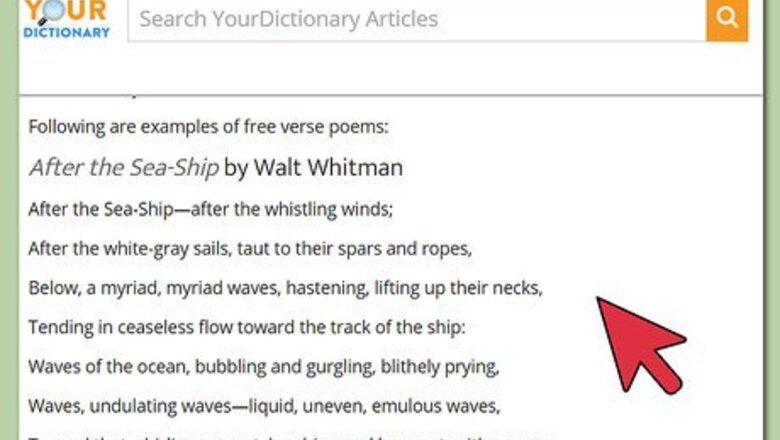
views
Choosing a Poetic Form
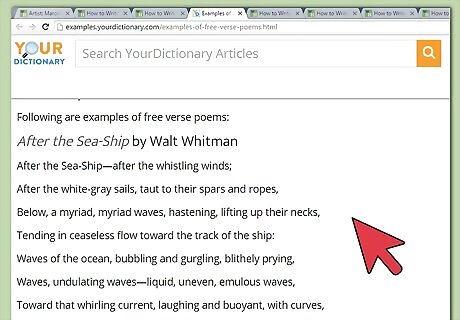
Use the free verse form. Perhaps the most freeing form in poetry is free verse, where you are not limited by line count, rhyming structure, or syllable count. However, if your aim is to write quick poems, you may put a limit on how many lines your free verse poem is going to be so it is on the shorter side. You may also decide to revise your free verse poem so it is cut down to the shortest possible lines. Doing this will force you to keep the poem quick and brief, but still meaningful and full of emotion.

Try the haiku form. Another way to compose a poem within a short timeframe is to choose a poetic form that is short. Haiku is a three line poem that uses the 5,7,5 syllable structure. It is a non-rhyming form, so you are not limited by rhyme when you write haiku. Often, haikus focus on nature and natural imagery. Keep in mind haiku is not a sentence broken up into three lines. Instead, each line of your haiku should stand on their own as individual thoughts, images, emotions, or responses. Your haiku should act as a snapshot that shows your reader how the speaker in the poem is feeling or what she is experiencing. Avoid telling or explaining and focus on showing instead. Examples of haiku include “Haiku Ambulance” by Richard Brautigan, “The Light of a Candle” by Yosa Buson, “5&7&5” by Anselm Hollo.
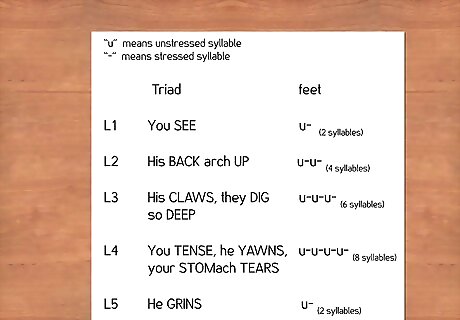
Use the cinquain form. This is a five line poem that contains twenty-two syllables total, following the pattern 2, 4, 6, 8, 2. So, the first line of the poem contains two syllables, the second line contains four syllables, the third line contains six syllables, and so on. Cinquains do not need to rhyme and they can focus on a variety of subjects. Cinquains are a great way to write about a specific topic or idea in very few lines. You also have the option of adding or removing one syllable from each line, giving you more freedom in this form. Examples of cinquains include “November Night” by Adelaide Crapsey, “To Helen” by Edgar Allen Poe, and “The World” by George Herbert.
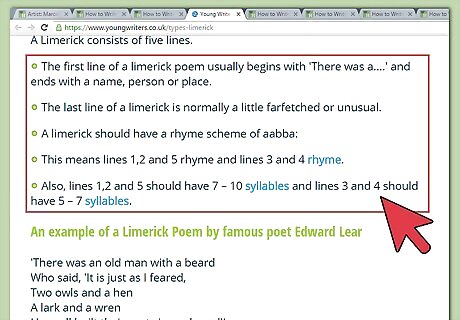
Do the limerick form. Limericks are great options if you have limited time to create a poem. These are five line poems that follow the rhyme scheme AABBA. Often, limericks are humorous and focus on a specific moment or situation. They are meant to act as poetic jokes or humorous asides. Limericks usually begin with the phrase “There was a…”. The line usually ends with a name, person, or place. Lines 1, 2, and 5 rhyme. Lines 3 and 4 rhyme. Lines 1,2, and 5 contain 7-10 syllables and lines 3 and 4 contain 5-7 syllables. Often the last line of a limerick presents an unusual image or a strange, funny idea, similar to the punchline in a joke. Examples of limericks include “There was an Old Man with a Beard” by Edward Lear, “There was a Small Boy of Quebec” by Rudyard Kipling, and “A Wonderful Bird is the Pelican” by Dixon Lanier Merritt.

Try the epigraph poetry form. In Greek, epigraph means “upon a tomb”. Epigraphs need to be short enough to fit on a tombstone and are often only one to two lines long. Often, they are written as a couplet, or two rhyming lines, or one line of text. Many epigraph poems are meant to be funny, making them fun to write. Examples of epigraph poems include “Epigram” by Samuel Taylor Coleridge and “Smoker’s Epitaph.”
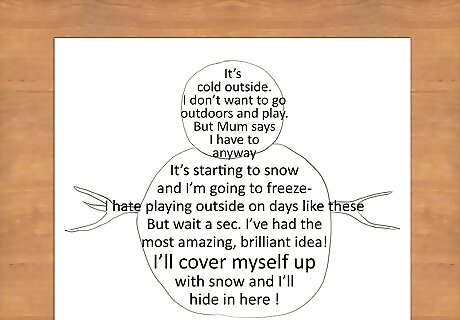
Make a short shape poem. Shape poems are also a fun way to write a poem quickly. You can choose pretty much any subject and write a poem in the shape or outline of the subject or object. Shape poems do not need to rhyme or follow a specific line count. Instead, you only need to write enough to fill the shape of the subject of the poem. Examples of shape poetry include “Concrete Cat” by Dorthi Charles, “Butterfly” by David Schondelmeyer, and “Vision and Prayer” by Dylan Thomas.
Brainstorming Ideas for the Poem
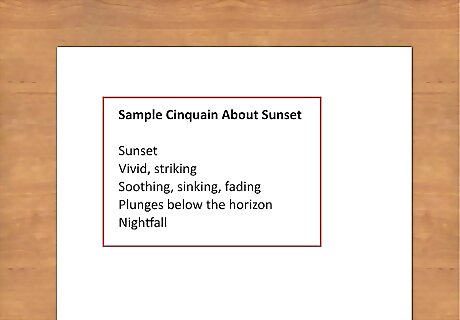
Write about an event in your day. Get inspiration for your poem by writing about a major event that occurred in your day or a funny moment that left an impact on you. This could be a test you aced in second period or a comment made by a friend in the hallway after school. Try to pick an event or moment that occurred recently, as it will be fresh in your mind and easier to write about. For example, you may decide to write a free verse poem about a conversation you had with your teacher that day. You may put limits on yourself by having the poem be only ten lines total or five lines total. You will then need to focus on certain details to fit the conversation into ten lines.
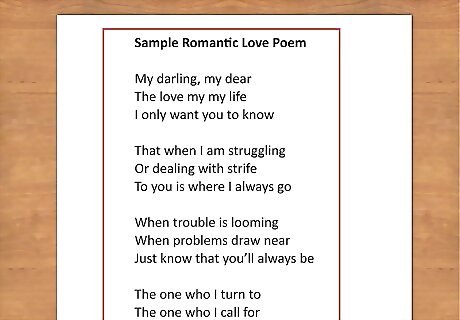
Focus on a current event or issue. You may also be inspired by a current event or issue, such as women’s reproductive rights, drug abuse, or homelessness. You may then use this issue as a jumping off point for your poem. Try to focus on your personal relationship with the issue and consider why this issue is so important and emotional for you. For example, you may decide to write about the dangers of drug abuse or the dangers of smoking cigarettes. You may then envision what it might be like to be a smoker or a drug user and discuss the dangers and fears a smoker or drug user might experience.

Write about your favorite spot in nature. Maybe you have a favorite spot in a park or a hiking spot you go to on the weekends. Perhaps your favorite spot in nature is actually your own backyard or a cluster of indoor plants on your windowsill. Focus on a spot in nature and describe emotions and feelings you experience when you are in this spot. This subject matter would be ideal for the haiku form, which often focuses on nature and the natural world. You may also try writing about nature in the cinquain form.
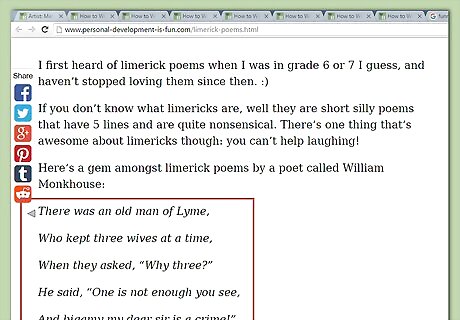
Compose a humorous poem about your best friend. You may be inspired by a funny moment with a best friend or someone close to you. You may decide to use this funny moment to write a funny poem that is fun to write and enjoyable to read. You may decide to use the limerick form or the epigraph poetry form for your humorous poem. These forms are a good way to organize and write about funny content quickly and effectively.

Create a poem from the perspective of an animal. Another fun prompt is to write a poem from the perspective of an animal, such as tiger or an elephant. You may choose to explore how it might feel to inhabit the body and mind of an animal. You may also use the perspective of an animal to discuss a difficult moment in your life or a challenging event. You may decide to use the form of a shape poem for this content, using your poem about the animal to fill the shape of the animal. This could allow you to create limitations around the content, as you will need to write enough lines in the poem to fill the shape of the animal.
Writing the Poem

Avoid cliche by using unfamiliar descriptions and phrases. Cliches are phrases or terms that have become so familiar and well known that they no longer hold meaning. Avoiding cliches will allow you to write poetry that is more engaging and nuanced. It will also force you to stretch your creativity and come up with descriptions that are unfamiliar and unique. For example, rather than describe a funny moment as “so funny I could die” or “I laughed so hard I cried”, you may try describing the moment with unfamiliar details, such as “I hooted and hollered until I ran out of breath” or “I let out a high-pitched squeal that bounced off the walls of the cafeteria.”
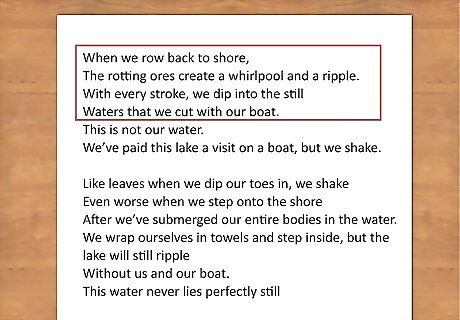
Use sensory details. Use all five senses to describe moments in your poem. Consider the sounds, smells, and tastes of an experience or moment, as well as how it felt and how it looked. Be specific when you use sensory detail so you can paint an engaging picture in your reader’s mind. For example, you may describe the feeling of standing in front of your favorite waterfall as “my face is covered in the briny thick smell of moss” or “I can taste the fresh water droplets that fall onto my face.”

Do quick first draft. To speed up the writing time, you may want to sit down and write a first draft of the poem in one sitting. You may have examples of your chosen poetic form nearby as well as notes from your brainstorming. Using these materials, you may then try to get your thoughts down on the page without editing or reading over your writing as you write. This can be a good technique if you are feeling stuck or uncertain of how to start. Forcing yourself to just write, without editing as you go, can help you to generate content that you can then pare down in your revisions.

Revise your poem. Once you have your quick first draft done, you should read over your writing and revise it so it is sharp and concise. Note any awkward phrases or cliches and replace them with more nuanced phrases. Look for any spots that you can cut or pare down. If you are using a particular poetic form, you should make sure your poem conforms to the form. For example, if you are using haiku, you should make sure each line contains the right number of syllables and flows well as a whole. You may also want to read your poem out loud to listen for any confusing language or unclear description. Read the poem to someone you trust to get their opinion and feedback. Getting a different perspective on the poem can make it that much stronger.

















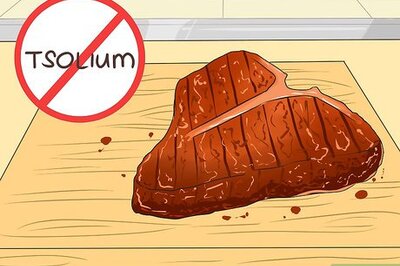


Comments
0 comment